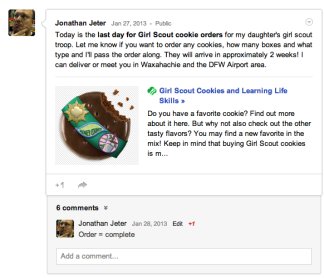 Being that it is Girl Scout cookie time again and my daughter had exhausted her cookie selling opportunities among our family, neighbors and friends, I decided I would make one last appeal for cookie orders on my social networks as the final order deadline approached. As I started to post my request on Facebook and Google+, I decided to try a little experiment to see what type of response I received on Facebook, compared to Google Plus.
Being that it is Girl Scout cookie time again and my daughter had exhausted her cookie selling opportunities among our family, neighbors and friends, I decided I would make one last appeal for cookie orders on my social networks as the final order deadline approached. As I started to post my request on Facebook and Google+, I decided to try a little experiment to see what type of response I received on Facebook, compared to Google Plus.
In Facebook, I posted a link to the Facebook page of my daughter’s Girl Scout Service Unit with the following text:
Today is the last day for Girl Scout cookie orders for my daughter’s girl scout troop. Let me know if you want to order any cookies, how many boxes and what type and I’ll pass the order along. They will arrive in approximately 2 weeks! I can deliver or meet you in Waxahachie and the DFW Airport area.
On Google+, I found that my daughter’s Girl Scout Troop didn’t have a Google+ page (which was not a surprise), so I shared an article that described all of the different types of Girl Scout Cookies available. I shared it with my co-workers, friends and family circles, knowing that if they also had me in their circles, they would see an indicator alerting them that I had shared a post with them. Facebook has the same functionality, but in reverse. If I had decided to receive alerts from select friends, I would also see the alert indicator.
 When I posted the same link and message on Facebook, I was offered the option of promoting my message. Knowing that not every one of my friends would necessarily see my message if I just posted it, I decided to give the Facebook Promoted Message a try and ponied up seven dollars to ensure that many more people would see the message. I also added a link to this article in a comment on the Facebook post.
When I posted the same link and message on Facebook, I was offered the option of promoting my message. Knowing that not every one of my friends would necessarily see my message if I just posted it, I decided to give the Facebook Promoted Message a try and ponied up seven dollars to ensure that many more people would see the message. I also added a link to this article in a comment on the Facebook post.
I was interested in seeing who would respond without being mentioned specifically, but I did mention my wife in the Facebook post, since she uses Facebook, but not Google+.
What were the results?
 I know this was not a scientific experiment and there were definitely variations in what and how the items were shared, but I was curious to see what the results would be. Both Facebook and Google+ have a way to show you how much exposure your post has received.
I know this was not a scientific experiment and there were definitely variations in what and how the items were shared, but I was curious to see what the results would be. Both Facebook and Google+ have a way to show you how much exposure your post has received.
My Facebook post received zero likes, comments and shares, so it was basically ignored by everyone who saw it, even though Facebook was kind enough to tell me that 11.4x more people ignored my post since I had promoted it.
My Google+ post received no +1’s or shares, but I did receive 6 comments, resulting in 2 orders for cookies.
What does this prove?
This little experiment proves absolutely nothing. No, really, it doesn’t prove anything, but it was a fun experiment. My takeaways are all conjecture, but here are my thoughts on the experiment.
My guess is that since this is the type of thing people see on Facebook frequently, the Facebook audience was probably over saturated with Girl Scout Cookie requests and hence ignored my post. On Google+, however, posts tend to be more technical, and a post about Girl Scout Cookies may stand out a little bit more. Also, those who interacted and ordered were people who I am highly engaged with on Google+.
So, if you’re coming up with a strategy for posting on your social media networks, remember that different types of posts tend to fare better on different networks, but at the same time, sometimes a post will stand out more and get more interaction precisely because it doesn’t fit into the typical type of post for that network.
What do you think? Why do you think a post would get more traction on one social network over the other? How do your social media strategies differ when posting on Facebook or Twitter or Google+?




